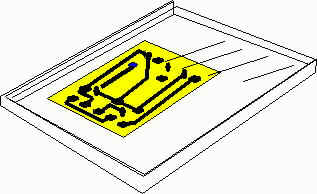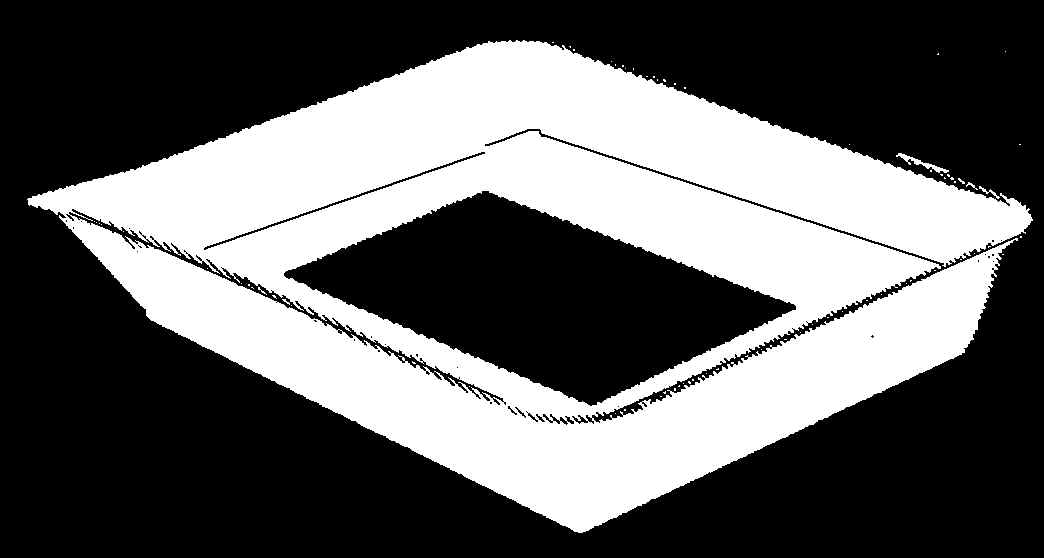
Fax : 414-327-0577
Email: indelect@execpc.com
Catalog, Quote, Availability.
 |
Call: 414-327-1555 Fax : 414-327-0577 Email: indelect@execpc.com Catalog, Quote, Availability. |
The NEGATIVE ACTING RESIST from Datak, Instructions.
(Did you want Positive
Instructions?) . (Copyright LKG Industries 2003)

The method is based upon using the Datak no. ER-71 Photo
Resist liquid, which is a light sensitive spray-on resist. The small, 4 ounce
bottle will cover about 1,700 square inches and is applied with the pump action
sprayer included in the package. Good results can be expected if you carefully
follow the steps.
NOTE: This process has been in use for many years. It works well when done
correctly. It requires careful attention to details (the instructions) to work
well. Beginners are referred to our pre-coated positive acting PC boards, which
are very forgiving and can usually produce good PC boards for the first-time
user. (See Positive Process.) The main attractions to
this Negative process are twofold: 1. you may coat any shape board and, 2. the
material can be very economical to use. Plus, it can be handy to have on hand
when an idea suddenly needs to be turned into a circuit.
You will need to begin with a quality
negative. If you have a positive, you will need to reverse it so that the circuit
is "clear" (transparent) and the background is opaque (black or equivalent).
If you do not have a method for making a negative, you might look into the DATAK
Neg-Fast film process. That process can be used to reverse in either direction.
A local photographic shop may be able to use a standard photographic process
to make a high contrast negative. (We will add NegFast film to the web in March.
In the mean time, you may request a Datak instructions booklet no. 12-760A by
asking for same at this and be sure to give us a postal address to send it to.
This offer good only in the USA.
Step 1. Clean the PC board. This is a critical step and must
be done well. Scour the board with water and a common kitchen cleanser (containing
bleach) and very fine steel wool. Scrub the board and rinse until water sheets
out evenly over the entire surface when you hold the board horizontally under
a pencil-lead strea m of water. If the water tends to pull away
from the boards edges or any point on the aboard, clean it again. If the board
cannot pass this water test, it is "dirty" (probably oily) and must be cleaned
until it passes.
m of water. If the water tends to pull away
from the boards edges or any point on the aboard, clean it again. If the board
cannot pass this water test, it is "dirty" (probably oily) and must be cleaned
until it passes.
Dry the cleaned board with paper towels. You could wipe with
ammonia (never with alcohol). Handle by the edges, don't touch the surface.
Step 2. Coat the Board with Resist. Do in very subdued light*
Ideal lighting could be a dark room or simply work in a room lighted only with
a yellow "bug" light or two (about 25 watts). The board should be warm, ideally
about 120 degrees F. Heat the board on a hot plate or you could warm it with
a heat gun or hair dryer.
Lay the board flat and spray a light, continuous film . (Serious
sink marks will indicate poor board cleaning.) Sight along the board surface
toward your light; make the coat as even as possible. (Some long time users
suggest using two very thin coats; drying thoroughly between applications.)
.jpeg)
Step 3. Drying the PC Board. The board may simply be place
in a dark cupboard to dry over night. Or, bake it in an oven at 140 degrees
F for twenty minutes; the oven must be dark. Allow the board to cool ten minutes
before use. Never expose it to room lighting, sunlight etc. and handle only
in the dark or above suggested lighting.
If your coating is not a clean looking, even coat with few
signs of bubbles, consider repeating the process by adding a second coat. Strive
for a thin coat, and as even as you can make it. A poorly coated board could
be cleaned off with developer to do over again.
Step 4. Exposing the PC Board. Place your negative on top of the resist coating
and place the two in a contact exposure frame. The frame will hold the negative
and board tightly together to prevent light from leaking between them.
Expose the board to light using one of the following choices:

1.) Sunlight at about noon, for three minutes.
2.) Datak no. ER-2000 bulb, for 3-1/2 to 4 minutes at a distance of 12" for
smaller boards. For Boards 5" x 5" up to 9" x 9" use a distance of 15" and five
minutes. Increase distance and time proportionately for larger boards. .
3.) Two F15T8BL bulbs 20 minutes at 15".
Step 5. Developing the PC Board...
You need two metal or glass photographic trays for developing
(never use plastic trays). If you work with small boards, find some smaller
trays which will save on developer.
Use only Datak developer no. ER-8. Place enough developer
in each tray so that the board is under the developer about 1/16" when
it is placed flat in the tray.

Note: The resist pattern is transparent during developing and cannot be easily
seen until it is completely dry. (Some users have learned to see the resist
by holding the board at an angle to the "bug" light. Seeing it is not really
necessary, however.)
NOTE: Use only developing trays made of Glass or
Metal (Datak no. 12-520). Never use plastic trays.
Work in a well ventilated area; the fumes from the developer can affect
some people; get into open air if you feel light headed.
Follow these developing steps:
a.) Place exposed board in first tray for 30 to 45 seconds,
gently rocking the tray every five seconds. (Never touch the surface of the
board, the resist will scratch easily. Handle by the edges.)
b.) Remove board, holding by the edges. Allow it to drain
for ten seconds and then place it face down on 2 or 3 layers of clean facial
tissue (don't slide or rub!). At this stage the resist is much like a soft,
gummy, swollen plastic.
c.) Carefully remove tissue and immerse the board in second
tray for ten seconds. Remove, allow it to dry and inspect the pattern against
the light (hold board flat and point it toward the light; sight along board).
Good developing shows up the pattern clearly with no drain marks or stains in
the areas to be etched. Old, used developer will leave globs at random.
Dry thoroughly before etching; at least ten minutes at room
temperature. The resist must be hard before etching. After five minutes of "air
time", you could dry further with a low setting on a hair dryer. A simple fan,
or a half hour of time in the open air will work too. The board no longer needs
darkness at this stage.
Step 6. Touch up. The board may now be handled in normal lighting. Inspect the
board for breaks in traces or pads. If there are any, you can touch them up
with the etch resist pen. Repair any breaks before etching.
If the above steps were done well, touch up will probably not be needed.
Etch the PC board. See the etching instructions on the bottom of the page for Positive Instructions. Etching may be done identically
for both, of course.
 |
Call: 414-327-1555 Fax : 414-327-0577 Email: indelect@execpc.com Catalog, Quote, Availability. |